
Jaguar is the sports car and luxury vehicle brand of Jaguar Land Rover, a British multinational car manufacturer with its headquarters in Whitley, Coventry, England. Jaguar Cars was the company that was responsible for the production of Jaguar cars until its operations were fully merged with those of Land Rover to form Jaguar Land Rover on 1 January 2013.

The Jaguar E-Type, or the Jaguar XK-E for the North American market, is a British front mid-engined sports car that was manufactured by Jaguar Cars Ltd from 1961 to 1974. Its combination of exceptional aesthetics, advanced technologies, high performance, and competitive pricing established the model as an icon of the motoring world. The E-Type's claimed 150 miles per hour (240 km/h) top speed, sub-7-second 0 to 60 mph (97 km/h) acceleration, largely unitary body construction, front and rear independent suspension with disc brakes, mounted inboard at the rear, and rack-and-pinion steering, distinguished the car and spurred industry-wide changes.

The Jaguar S-Type is an executive car that debuted at the 1998 Birmingham Motor Show and was marketed by Jaguar for model years 1999–2007, reviving the nameplate of the company's 1963–68 S-Type as a four-door notchback saloon. The S-Type received a mild facelift for the 2002 model year and again in 2004. The S-Type was discontinued in late 2007 and replaced by the XF.

The Jaguar XJ is a series of mid-size/full-size luxury cars produced by British automobile manufacturer Jaguar Cars from 1968 to 2019. It was produced across five basic platform generations with various updated derivatives of each. From 1970, it was Jaguar's flagship four-door model. The original model was the last Jaguar saloon to have been designed under the leadership of Sir William Lyons, the company's founder, and the model has been featured in countless media and high-profile appearances.
Birchfield Motor Company of Rockingham, Western Australia was a small Australian specialty car manufacturer, making replicas of the 1937 SS Jaguar model on individual orders. Birchfield is the continuation of earlier British Shapecraft that is known to have built 18 replicas.

The Jaguar XK is an inline 6-cylinder dual overhead camshaft (DOHC) engine produced by Jaguar Cars between 1949 and 1992. Introduced as a 3.4-litre, it earned fame on both the road and track, being produced in five displacements between 2.4 and 4.2-litres for Jaguar passenger cars, with other sizes being made by Jaguar and privateers for racing. A de-rated version was also used in certain military vehicles built by Alvis and Daimler.

The Jaguar Mark X, later renamed the Jaguar 420G, was British manufacturer Jaguar's top-of-the-range saloon car for a decade, from 1961 to 1970. The large, luxurious Mark X not only succeeded the Mark IX as the company's top saloon model, but radically broke with both its predecessor's styling and technology.

Brough Superior motorcycles, sidecars, and motor cars were made by George Brough in his Brough Superior works on Haydn Road in Nottingham, England, from 1919 to 1940. The motorcycles were dubbed the "Rolls-Royce of Motorcycles" by H. D. Teague of The Motor Cycle newspaper. Approximately 3048 motorcycles were made in the 21 years of production; around a third of that production still exists. T. E. Lawrence owned eight of these motorcycles and died from injuries sustained when he crashed number seven; the eighth was on order. Moving forward to 2008, vintage motorcycle enthusiast Mark Upham acquired the rights to the Brough Superior name. In 2013 he met motorcycle designer Thierry Henriette and asked him to design a new Brough Superior motorcycle. Three months later a prototype of a new SS100 was shown in Milan.

The Jaguar XJ220 is a two-seat sports car produced by British luxury car manufacturer Jaguar from 1992 until 1994, in collaboration with the specialist automotive and race engineering company Tom Walkinshaw Racing. The XJ220 recorded a top speed of 212.3 mph (341.7 km/h) during testing by Jaguar at the Nardo test track in Italy. This made it the fastest production car from 1992 to 1993. According to Jaguar, an XJ220 prototype managed a Nürburgring lap time of 7:46.36 in 1991 which was faster than any production car lap time before it.

Sir William Lyons, known as "Mr. Jaguar", was with fellow motorcycle enthusiast William Walmsley, the co-founder in 1922 of the Swallow Sidecar Company, which became Jaguar Cars Limited after the Second World War.
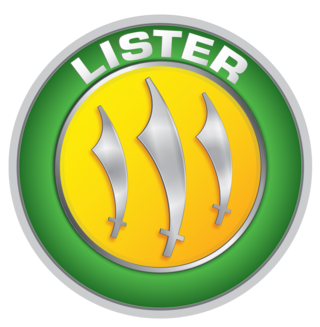
Lister Motor Company Ltd is a British sports car manufacturer founded by Brian Lister in 1954 in Cambridge, England, which became known for its involvement in motorsport. After buying the company in 1986, Laurence Pearce produced variants of the Jaguar XJS before producing a bespoke sports car, the Lister Storm. In 2013, Lister Cars was acquired by Lawrence Whittaker's company Warrantywise. Production of the original sports car restarted in 2014 and ten continuation Lister Jaguar Knobblys were built to celebrate Lister's 60th Anniversary. In 2016, the company announced the build and sale of the Lister Knobbly Stirling Moss. On 31 January 2018, the Lister LFT-666 based on the Jaguar F-Type was announced.

The Jaguar Mark 2 is a mid-sized luxury sports saloon built from late 1959 to 1967 by Jaguar in Coventry, England. The previous Jaguar 2.4 Litre and 3.4 Litre models made between 1955 and 1959 are identified as Mark 1 Jaguars.

The Peugeot 604 is an executive car produced by the French manufacturer Peugeot from 1975 to 1985. 153,252 cars were sold during its 10-year production life. It was made in France and also assembled by Kia in South Korea, between 1979 and 1981.
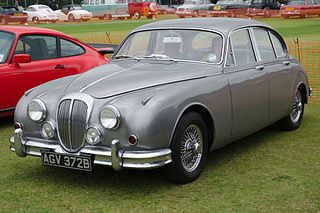
The Daimler 2.5 V8/V8-250 is a four-door saloon which was produced by The Daimler Company Limited in the United Kingdom from 1962 to 1969. It was the first Daimler car to be based on a Jaguar platform, the first with a unit body, and the last to feature a Daimler engine after the company was bought from the Birmingham Small Arms Company by Jaguar Cars in 1960. The engine is the hemispherical head V8 designed by Edward Turner and first used in the Daimler SP250 sports car.
SS Cars was a British manufacturer of sports saloon cars from 1934 until wartime 1940, and from March 1935 of a limited number of open 2-seater sports cars. From September 1935, their new models displayed a new name: SS Jaguar. By then, its business, which was founded in 1922, was run by and largely owned by William Lyons. Lyons had been partner with 1922 co-founder William Walmsley until Walmsley sold his shareholding in January 1935.
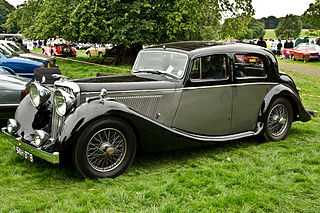
The Jaguar Mark IV is a range of automobiles built by Jaguar Cars from 1945 to 1949. The cars were marketed as the Jaguar 1½ litre, Jaguar 2½ litre and Jaguar 3½ litre with the Mark IV name later applied in retrospect to separate this model from the succeeding Mark V range.
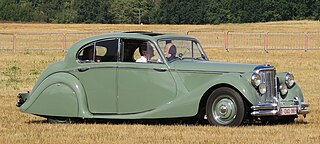
The Jaguar Mark V is a luxury automobile built by Jaguar Cars Ltd of Coventry in England from 1948 to 1951. It was available as a four-door Saloon (sedan) and a two-door convertible known as the Drop Head Coupé, both versions seating five adults. It was the first Jaguar with independent front suspension, first with hydraulic brakes, first with spats, first specifically designed to be produced in both Right and Left Hand Drive configurations, first with disc centre wheels, first with smaller wider 16" balloon tyres, first to be offered with sealed headlamps and flashing turn signals for the important American market, and the last model to use the pushrod engines.

The Jaguar Mark 1 is a British saloon car produced by Jaguar between 1955 and 1959. It was referred to in contemporary company documentation as the Jaguar 2.4 Litre and Jaguar 3.4 Litre. Its designation as Mark 1 was retroactive, following its October 1959 replacement by Jaguar's 2.4-litre Mark 2. The 2.4 Litre was the company's first small saloon since the end of its 1½ and 2½ Litre cars in 1949, and was an immediate success, easily outselling the larger much more expensive Jaguar saloons.
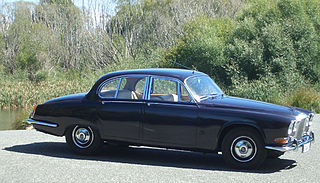
Daimler Sovereign was a name applied by British manufacturer Jaguar Cars to a sequence of luxury automobiles built by it but carrying the Daimler badge between 1966 and 1983.
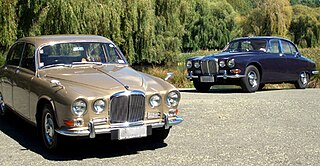
The Jaguar 420 and its Daimler Sovereign equivalent were introduced at the October 1966 London Motor Show and produced for two years as the ultimate expression of a series of "compact sporting saloons" offered by Jaguar throughout that decade, all of which shared the same wheelbase. Developed from the Jaguar S-Type, the 420 cost around £200 more than that model and effectively ended buyer interest in it, although the S-Type continued to be sold alongside the 420/Sovereign until both were supplanted by the Jaguar XJ6 late in 1968.























